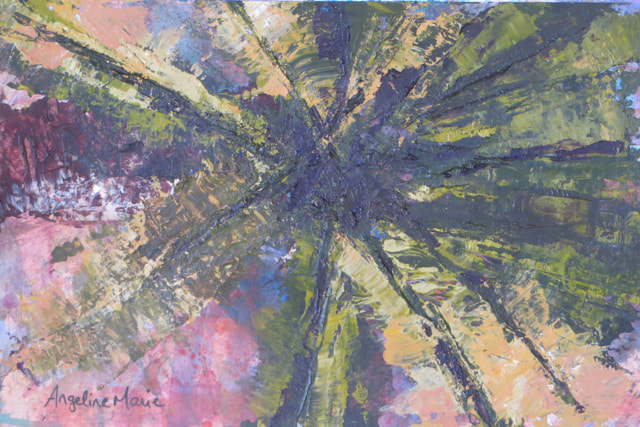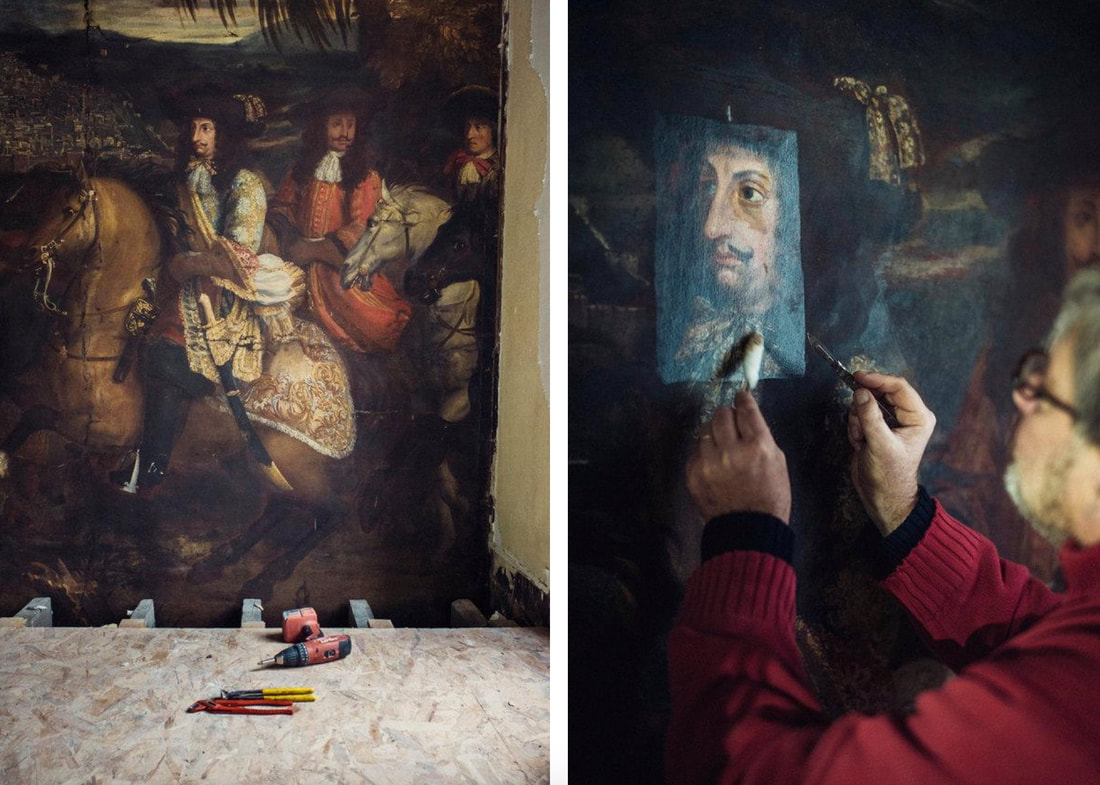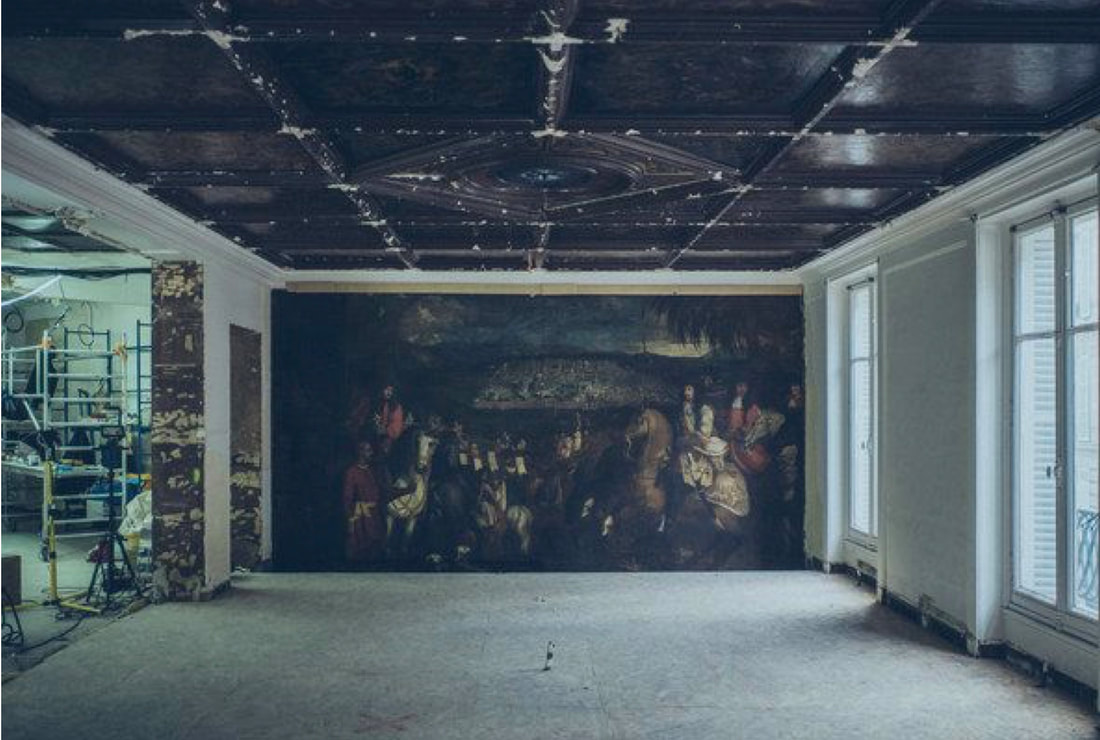|
4/3/2019 painting lost for 300 yearsPalette Knife Palm Tree Study, 3 by 5 inches, acrylics on paper Ok, my painting wasn't lost for 300 years, but I know of one that was!!!
Have you ever remodeled your home? Watched the TV shows that have houses remodeled? Andy & I will sometimes spend a little while, physically tired, in front of the TV to watch a house remodeling show. We watch from house hunting to the brothers. The article I include here is of a store remodel, in Paris, France. A painted mural was uncovered that is over 300 years old!!!!!!!!!!!!! It was found behind a wall in a luxury brand's store. Based on my resources, I'd've had the wall cut out and sold to someone who could do all the restoration and care that it needs! Over 300 years old...! If I were returning to Paris, I would visit this store just to see this painting! Never, in any of the home shows we've watched, has a painted mural that was by a master been found, lol. To think of it, only one house was even designed by a master architect, lol! Do you have a fantasy of finding a long lost art treasure? What would YOU do if you found a historical painting mural in your house? Smiles, with paint on my hands, Angeline You can link to article here: https://www.nytimes.com/2019/01/21/fashion/the-treasure-behind-the-wall.html or read on: The Treasure Behind the WallSomething in the new Oscar de la Renta boutique in Paris was not what it seemed. https://www.nytimes.com/2019/01/21/fashion/the-treasure-behind-the-wall.html The 17th-century oil painting discovered behind a wall during construction of the Oscar de la Renta boutique in Paris. Credit Julien Mignot for The New York Times Image The 17th-century oil painting discovered behind a wall during construction of the Oscar de la Renta boutique in Paris. CreditCreditJulien Mignot for The New York Times By Vanessa Friedman Jan. 21, 2019 Alex Bolen, the chief executive of Oscar de la Renta, planned to have his new store in Paris open around this week, just in time for the couture shows. He planned to have a presence in the city even if he didn’t have a show. He had it all figured out. Then, last summer, in the middle of renovations, Mr. Bolen got a call from his architect, Nathalie Ryan. “‘We made a discovery,’” he remembered her saying. On the other end of the phone, Mr. Bolen cringed. The last time he received a call like that about a store, their plans to move a wall had to be scrapped because of fears the building would collapse. He asked what, exactly, the discovery was. “You have to come and see,” she told him. So, gritting his teeth, he got on a plane from New York. Ms. Ryan took him to the second floor of what would be the shop, where workers were busily clearing out detritus, and gestured toward the end of the space. Mr. Bolen, she said, blinked. Then he said: “No, it’s not possible.” Something had been hidden behind a wall, and it wasn’t asbestos. It was a 10-by-20-foot oil painting of an elaborately coifed and dressed 17th-century marquis and assorted courtiers entering the city of Jerusalem. “It’s very rare and exceptional, for many reasons,” said Benoît Janson, of the restoration specialists Nouvelle Tendance, who is overseeing work on the canvas. Namely, “its historical and aesthetic quality and size.” Boutique renovations, like most renovations, are often delayed. They frequently run over budget. But rarely are they delayed and over budget because a mysterious artwork more than three centuries old has resurfaced. In the arms race for the most unique! most authentic! store currently underway, when only-in-person experience is what differentiates retail from e-tail, a cultural treasure surrounded by a puzzle straight out of a Dan Brown novel may be the ultimate accessory.Be Careful What You Wish ForMr. Bolen had been looking for a store in Paris for a long time. In the early 1990s, the company had a small boutique in the city during Mr. de la Renta’s tenure as couturier of Balmain, but the boutique closed after he left the brand in 2002. (He died in 2014.)In 2017, Mr. Bolen was offered the former Reed Krakoff store on Rue de Marignan, a diagonal side street off the luxury thoroughfare Avenue Montaigne, which terminates on one end at L’Avenue, the high-fashion canteen. Mr. Bolen liked the location, and the building, which had been built in the 19th century and remained largely in the hands of one family, many of whom still lived in the upstairs apartments. Still, he wanted a larger site, and when the office space that spanned the second floor became available, he grabbed it. “It was pretty charmless,” he said. A former insurance brokerage, it had a dropped ceiling with fluorescent lighting, particleboard walls and industrial carpeting in its rabbit warren of offices. “We knew we’d have to take everything out,” Mr. Bolen said. The idea was to link the two floors with a grand staircase. The ground floor and part of the second would serve as the boutique, and a room at the end would be used as a showroom and event space, with other space for offices and storage. The interior, designed by Jeang Kim and Will Kim of Oro Studio, would feel less like a big white box than a home for “young people who had just moved into their grandmother’s grand apartment,” according to Ms. Kim (who is also the sister of Oscar de la Renta’s co-creative director Laura Kim; she is not related to Mr. Kim). Image The restoration is expected to be done by May.CreditJulien Mignot for The New York Times Image Benoît Janson, a restoration specialist, works on the painting.CreditJulien Mignot for The New York Times Not long after the demolition began, a discovery was made. A workman, tearing down the dropped ceiling in the last room on the second floor, said there was something “strange.” That would be a paneled ceiling that had been underneath the visible one, composed of 29 inset squares, eight of them painted with different heraldic seals, and a central diamond. Dating from the mid-19th-century, they were well preserved since they had been recessed within the coffers of the ceiling. Still, while that was an interesting reveal, it was not unprecedented in a building of that age. It was when workers began removing the particleboard along the side and a chunk of the wall came off too that things got interesting. “Oh my God, it was — wow,” said Ms. Ryan, who was the in-house architect for Dior for many years and opened her own company, Kirei Studio, in 2010. Behind the wall a single painting, dark with age, ran from end to end. “Sometimes when you work on castles, you find something, but usually it’s a hidden fireplace, or in Italy, maybe a fresco,” Ms. Ryan said. “But in an apartment? In a store?” She had never seen anything like it. “Everyone freaked out,” Ms. Kim said. “It was like finding a mummy. I turned off my phone immediately and just looked at it. Nothing like this had ever happened in my work before.” Demolition was halted to figure out what the painting was and how it came to be in what was about to be a shop. Seeing the aristocrats on horseback and the mosque in the picture, Mr. Bolen said, visions of Crusaders and Knights Templar began to dance in his head. “I think maybe I have seen too many movies,” he said. A WhodunitIn the game of six degrees of separation, this was a good one: Mr. Bolen’s mother-in-law, Annette de la Renta, had cousins (via her mother, Jane Engelhard) who had married into the de La Rochefoucauld family, storied members of the French aristocracy. One of those family members happened to live across the street from the new de la Renta boutique. So when the painting was found, and it became clear Mr. Bolen would have to talk to the building’s owners, whom he had never met (the lease had been negotiated through a broker), his relative was able to make the introductions. Another de La Rochefoucauld, who happened to work at the Louvre, got a recommendation for an art historian: Stephane Pinta of the Cabinet Turquin, an expert in old-master paintings. Mr. Pinta determined that the painting was an oil on canvas created in 1674 by Arnould de Vuez, a painter who worked with Charles Le Brun, the first painter to Louis XIV and designer of interiors of the Château de Versailles. After working with Le Brun, de Vuez, who was known for getting involved in duels of honor, was forced to flee France and ended up in Constantinople. Mr. Pinta traced the painting to a plate that was reproduced in the 1900 book “Odyssey of an Ambassador: The Travels of the Marquis de Nointel, 1670-1680” by Albert Vandal, which told the story of the travels of Charles-Marie-François Olier, Marquis de Nointel et d’Angervilliers, Louis XIV’s ambassador to the Ottoman Court. On Page 129, there is a rotogravure of an artwork depicting the Marquis de Nointel arriving in Jerusalem with great pomp and circumstance — the painting on the wall. But how it ended up glued to that wall, no one knew, nor why it was covered up. There was speculation that maybe it happened during World War II, given the setting. It could be “a fog-of-war issue,” Mr. Bolen said. What everyone did know was that it would be dangerous to move because of how the painting had been attached to wall: backed by gauze and glued on. And, Mr. Bolen said, his wife, Eliza, told him, “If you move that painting, you will have 100 years of bad luck.” He thought she was probably right. The Next Mystery Instead, Mr. Bolen reached an agreement with the building’s owners: He would restore the painting if they agreed to let it remain in the store while the store was a tenant (the initial lease is for 10 years). Mr. Janson got to work in late November. “It was very dark because of all the overpaint from earlier restorations and varnish,” Mr. Janson said. Teams of restorers swab away some of the varnish to allow colors to come through. Credit Julien Mignot for The New York Times Image Teams of restorers swab away some of the varnish to allow colors to come through.CreditJulien Mignot for The New York Times For the last two months, a team of three to five people have laboriously swabbed away some of the varnish to allow the colors to come through. They hope to be finished by May, Mr. Janson said, though Mr. Bolen believes it will be sooner than that. Slowly, details that confirmed the painting’s provenance have begun to emerge: the mosque, the Western Wall, the elaborate brocades of the visiting Frenchmen. The discovery demanded something of a interior rethink as well as some practical changes. Ms. Kim has been haunting auctions for furniture from different periods to link past to present, including Marcel Breuer chairs and pieces from Pierre Bergé’s estate. “We’re not going to put a wall of dresses in front,” Ms. Ryan said. Security will be increased, and the 10 floor-to-ceiling windows on the second floor equipped with treated glass. The plan is to open in late spring. In the meantime, Mr. Bolen has not given up the search. “I need to get a heraldic expert in to look at the ceiling,” he said, sifting through photographs and pointing at some of the shields. “That one has three stars, a royal crown — and fish?” He looked at another one. “What do those three stars mean?” he wondered. “I don’t know. But that’s worth finding out.” He looked excited. Shoppers with a yen for a conspiracy theory or a taste of history may be, too. Vanessa Friedman is The Times's fashion director and chief fashion critic. She was previously the fashion editor of the Financial Times. @VVFriedman Comments are closed.
|
CategoriesAll Art In The News Art Studio Cats Classes Costa Rica Painting Painting Studio Pets Sketching Drawing, painting both analog and digital, and other artsy things while living in Costa Rica.
You can follow my blog the easiest by adding your email to my list by going here. I keep that list secret because I don’t like spammers, too. You’ll even get things that I don’t share in my blogs! |




 RSS Feed
RSS Feed
